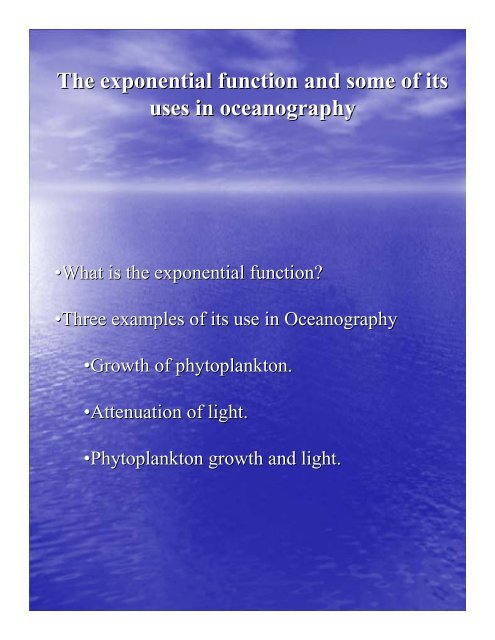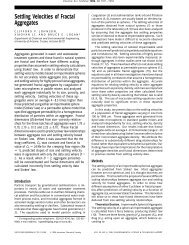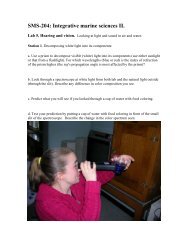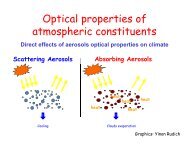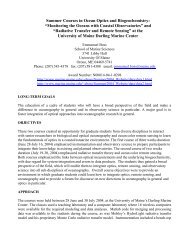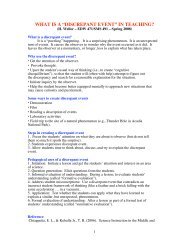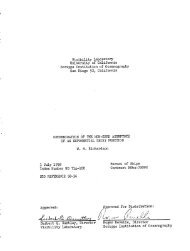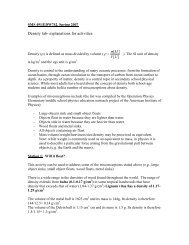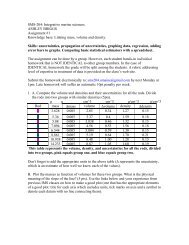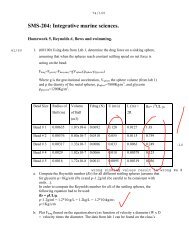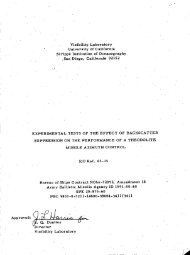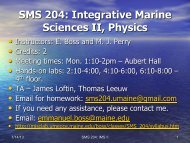Exponential function Lab.pdf
Exponential function Lab.pdf
Exponential function Lab.pdf
Create successful ePaper yourself
Turn your PDF publications into a flip-book with our unique Google optimized e-Paper software.
The exponential <strong>function</strong> and some of its<br />
uses in oceanography<br />
•What is the exponential <strong>function</strong>?<br />
•Three examples of its use in Oceanography<br />
•Growth of phytoplankton.<br />
•Attenuation of light.<br />
•Phytoplankton growth and light.
The exponential <strong>function</strong>:<br />
f(x)=Ae<br />
(Bx) , e=2.71828183<br />
2.71828183…<br />
Note: any power <strong>function</strong> can be<br />
translated to exponentials:<br />
a x =(e ln(a) ) x = e xln(a)<br />
= 1+<br />
x<br />
+<br />
x<br />
2<br />
2<br />
+<br />
3<br />
x<br />
3!<br />
+ ....<br />
e x ( )<br />
•Derivative proportional to the <strong>function</strong><br />
which means in solve the differential<br />
equation:<br />
df x<br />
dx<br />
=<br />
Bf<br />
( x)
Probabilities and the exponential <strong>function</strong>:<br />
You have 100 pennies.<br />
1. Toss them and take out all that are ‘head’.<br />
2. Keep tossing and write down the number of<br />
heads you got per toss.<br />
3. When done, use Excel plot the number of<br />
heads you got as a <strong>function</strong> of tosses.<br />
4. Fit an exponential <strong>function</strong> to the data.<br />
What is the exponent of the best fit? Is it<br />
sensible?<br />
5. ln{1/2}=-0.69.<br />
6. What if you had 100 dice. How would the<br />
curve change?
Coin toss results:<br />
Probabilities and the <strong>Exponential</strong> Function<br />
120<br />
100<br />
80<br />
y = 92.634e -0.6586x<br />
R 2 = 0.9947<br />
Group 1<br />
60<br />
40<br />
20<br />
0<br />
0 1 2 3 4 5 6 7 8<br />
Toss #<br />
Probabilities and the <strong>Exponential</strong> Function<br />
120<br />
100<br />
80<br />
y = 98.185e -0.6612x<br />
R 2 = 0.9547<br />
Group 2<br />
60<br />
40<br />
20<br />
0<br />
0 1 2 3 4 5 6 7 8<br />
Toss #
Phytoplankton growth:<br />
You have a series of data from a<br />
phytoplankton growth experiment (thank you<br />
Kate) where chlorophyll fluoresence (chl<br />
F )<br />
was used as an indicator of phytoplankton<br />
biomass.<br />
day<br />
1 2 6 8 10<br />
Chl F<br />
0.34<br />
1.17<br />
16.53<br />
30.1<br />
37.4<br />
Plot the data of chl F as <strong>function</strong> of time<br />
and ‘best’ fit:<br />
P(t)=P(t=0)e μt<br />
How would you go about calculating the<br />
doubling (halving?) time of the<br />
phytoplankton?<br />
Doubling time:<br />
P(t 2 )=P(t=0)exp(μt 2 )=2P(t=0)<br />
exp( exp(μt 2 )=2 t 2 =ln(2)/μ.<br />
ln(2)~0.7
Phytoplankton growth results:<br />
Phytoplankton Growth<br />
80<br />
70<br />
60<br />
y = 0.3386e 0.5305x<br />
R 2 = 0.9315<br />
50<br />
40<br />
30<br />
20<br />
10<br />
0<br />
0 2 4 6 8 10 12<br />
Days<br />
Doubling time = 1.08 days
Phytoplankton growth:<br />
How fast to phytoplankton concentration<br />
increase during the spring bloom?<br />
1. GoMOOS data from E01 for 2007.<br />
2. Based on the chlorophyll data estimate the<br />
growth rate? µ = 0.2962<br />
Phytoplankton Growth rate (GOMOOS data)<br />
14<br />
12<br />
10<br />
y = 0.8377e 0.2962x<br />
R 2 = 0.9564<br />
8<br />
6<br />
4<br />
2<br />
0<br />
0 1 2 3 4 5 6 7 8 9 10<br />
Day
How does it compare to lab cultures? What<br />
may be the reason for<br />
agreement/disagreement?<br />
The growth rate is much slower than lab<br />
cultures. Some reasons for the discrepancy<br />
include: limited light/nutrients and/or<br />
predation by grazers.
Transmission of light:<br />
Beer’s s law and the exponential <strong>function</strong>:<br />
Measure the intensity of light at the receiver when<br />
only water is in the tank.<br />
Add drops of dye (such that total drops in the tank= 1,<br />
2, 4, 8, 16, 32). Measure light intensity in each case.<br />
Light meter<br />
Light source
Plot the ratio of light intensity with dye divided by<br />
light intensity in tap water as <strong>function</strong> of drops of<br />
dye.<br />
Transmission of Light<br />
1600<br />
1400<br />
1200<br />
y = 952.05e -0.1678x<br />
R 2 = 0.9123<br />
1000<br />
800<br />
600<br />
400<br />
200<br />
0<br />
0 2 4 6 8 10 12 14 16 18<br />
# of drops<br />
Could you use your results to predict how<br />
many drops of dye are in another tank?<br />
Yes!<br />
This is the basis of spectroscopy!
Scientists use underwater<br />
spectrophotometer to investigate the<br />
ocean:
Light attenuation in the environment:<br />
E(λ,z)=E(λ,0)e (-k(λ)z)<br />
Blue ocean<br />
Coastal ocean<br />
Inland pond
Basic<br />
instrument to<br />
measure water<br />
quality. The<br />
secchi disk:<br />
Secci depth: Depth at which disk disappears.
Saturated growth:<br />
How much carbon is fixed at a given light level?<br />
P=P max (1-exp(-I/I k ))<br />
P max =P max (T,N)
Summary:<br />
•The exponential <strong>function</strong> can be used to describe many<br />
processes in the ocean. Knowing it and how to<br />
manipulate it allows one to better predict and<br />
understand the environment.<br />
•It turns out that e x with x imaginary is simply related<br />
to the sine and cosine <strong>function</strong>s simplifying much the<br />
proof of trigonometric identities facilitate the<br />
formulation and study of waves.<br />
•If learning by humans followed the model:<br />
Dk/dt=μk<br />
imagine what a little change in knowledge acquisition<br />
rate (μ) can do to society!<br />
•But remember, things can’t keep growing exponentially<br />
forever; after a finite time we reach the carrying<br />
capacity of the system/environment…
Teaching the exponential <strong>function</strong><br />
Resource: http://faculty.gvsu.edu/goldenj/exponential.html<br />
Some highlights<br />
The exponential <strong>function</strong> and probability:<br />
http://faculty.gvsu.edu.goldenj.badpenny.html<br />
Exploring growth patterns:<br />
http://score.kings.k12.ca.us/lessons/growth.html<br />
In marine sciences we see the exponential <strong>function</strong> showing up<br />
in many applications:<br />
1. Light decrease with depth in the ocean.<br />
2. Phytoplankton growth when supplied with a given light<br />
level of light and nutrients.<br />
3. Nuclear decay.


